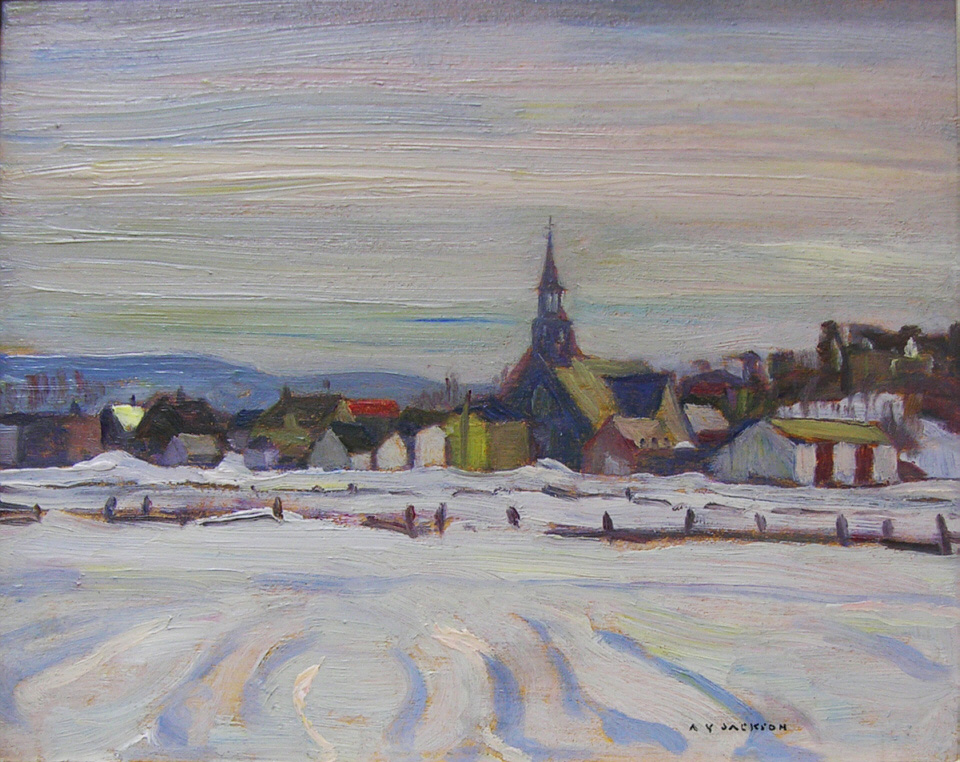Saint-Pierre-Montmagny Quebec
Oil on panel, April 1942
8.5 x 10.5 in.
Alexander Young Jackson, CC, CMG October 3, 1882 in Montreal, Quebec – April 5, 1974 in Toronto, Ontario) was a Canadian painter and founding member of the Group of Seven.
As a young boy, Jackson worked as an office boy for a lithograph company, after his father abandoned the family of six children. It was at this company that Jackson began his art training. In the evenings, he took classes at Montreal’s Le Monument National.
In 1905, he worked his way to Europe on cattle boat, returning by the same means and travelling on to Chicago. In Chicago, he joined a commercial art firm and took courses at the Art Institute of Chicago. He saved his earnings and, by 1907, was able to visit France to study Impressionism. In France, he decided to become a professional painter, and studied at Paris Academie Julian under J.P. Laurens. He also visited Italy and the Netherlands. Jackson painted in an Impressionist style.
Jackson returned to Canada, settling in Sweetsburg, Quebec, where he began painting works such as The Edge of Maple Wood. He held his first single artist exhibition at the Montreal Art Gallery with Randolph Hewton in 1913. Unable to make ends meet and discouraged by the Canadian art scene, he considered moving to the United States. However, he received a letter from J. E. H. MacDonald and changed his mind.
MacDonald inquired about The Edge of Maple Wood, which he had seen at a Toronto art show. MacDonald said that Toronto artist Lawren Harris wanted to purchase the painting, if Jackson still owned it. Harris purchased the painting and Jackson struck up correspondence with the Toronto artists, often debating Canadian art. Jackson soon began long visits to Toronto.
In his visits, A.Y. Jackson often joined the painters who would one day be known as the Group of Seven on major trips to Algonquin Park, Georgian Bay, Algoma and the North Shore. Like the other Group painters, Jackson embraced landscape themes and sought to develop a bold style. An avid outdoorsman, Jackson became good friends with Tom Thomson, and the duo often fished and sketched.
In 1910, Harris convinced Jackson to spend the summer painting in Georgian Bay. A local doctor offered use of his cottage, a studio and paid expenses. Jackson enlisted in the Canadian Army’s 60th battalion in 1915. Private Jackson was wounded at the Battle of Sanctuary Wood in June 1916, soon after he reached the front. After recovering from his injuries, he was transferred to the Canadian War Records branch as an artist. He later worked for the Canadian War Memorials as an official war artist from 1917 to 1919.
Afterwards, Jackson returned to Toronto, often making painting expeditions to the lower St Lawrence, the Arctic, and British Columbia.
Timeline
- In 1919 Jackson and six painter colleagues formed the Group of Seven. These artists were considered bold, because the Canadian wilderness had previously been considered too rugged and wild to be painted.
- In 1925, he taught at the Ontario College of Art (OCA), in Toronto; this was the only year that he missed his annual spring trip to Quebec.
- In 1933, Jackson helped found the Canadian Group of Painters.
- In 1955, He moved to the Ottawa region settling in Manotick.
- In 1958 he published A Painter’s Country,his autobiography, dedicated to the memory of J.E.H. MacDonald, who visualized a Canadian school of painting and devoted his life to the realization of it.
- In 1964, Jackson submitted his own design during the Great Flag Debate, a similar design to the Pearson Pennant.
- In 1974, Jackson died over the Easter holiday in a nursing home in Toronto. He is buried on the grounds of the McMichael Gallery in Kleinberg.
Video NFB link: http://www.nfb.ca/film/canadian_landscape/
Bio courtesy of: http://en.wikipedia.org/wiki/A._Y._Jackson

